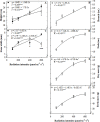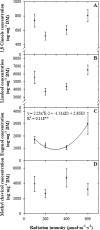Basil seedling production environment influences subsequent yield and flavor compound concentration during greenhouse production
- PMID: 36006946
- PMCID: PMC9409542
- DOI: 10.1371/journal.pone.0273562
Basil seedling production environment influences subsequent yield and flavor compound concentration during greenhouse production
Abstract
Radiation intensity and carbon dioxide (CO2) concentration can be precisely controlled to manipulate plant yield and quality. Due to increased plant densities during seedling production, fewer inputs per plant are required, creating the potential to increase production efficiency. Therefore, the objectives of this research were to: 1) quantify the extent radiation intensity and CO2 concentration under sole-source lighting influence morphology and yield of sweet basil (Ocimum basilicum) seedlings, and 2) determine if differences in morphology, yield, and volatile organic compound (VOC) concentration persist after transplant in a common environment. Sweet basil 'Nufar' seedlings were grown in growth chambers with target CO2 concentrations of 500 or 1,000 μmol·mol‒1 under light-emitting diodes (LEDs) providing target photosynthetic photon flux densities (PPFD) of 100, 200, 400, or 600 μmol·m‒2·s‒1 for 16 h per day. After two weeks, seedlings were transplanted into a common greenhouse environment and grown until harvest. At transplant and three weeks after transplant (harvest), growth and developmental differences were quantified along with key terpenoid and phenylpropanoid concentrations at harvest. Radiation intensity and CO2 interacted influencing many aspects of plant morphology, though CO2 concentration effects were less pronounced than those of radiation intensity. As radiation intensity during seedling production increased from 100 to 600 μmol·m‒2·s‒1, basil seedlings were 38% taller, had a 713% larger leaf area, and had 65% thicker stems; at harvest, plants were 24% taller, had 56% more branches, 28% more nodes, 22% thicker stems, and weighed 80% more when fresh and dry. Additionally, after growing in a common environment for three weeks, eugenol concentration was greater in plants grown under a PPFD of 600 μmol·m‒2·s‒1 as seedlings compared to lower intensities. Therefore, increasing radiation intensity during seedling production under sole-source lighting can carry over to increase subsequent yield and eugenol concentration during finished production.
Conflict of interest statement
The authors have declared that no competing interests exist.
Figures




Similar articles
-
Leveraging Controlled-Environment Agriculture to Increase Key Basil Terpenoid and Phenylpropanoid Concentrations: The Effects of Radiation Intensity and CO2 Concentration on Consumer Preference.Front Plant Sci. 2021 Jan 14;11:598519. doi: 10.3389/fpls.2020.598519. eCollection 2020. Front Plant Sci. 2021. PMID: 33597958 Free PMC article.
-
Narrowband Blue and Red LED Supplements Impact Key Flavor Volatiles in Hydroponically Grown Basil Across Growing Seasons.Front Plant Sci. 2021 Feb 26;12:623314. doi: 10.3389/fpls.2021.623314. eCollection 2021. Front Plant Sci. 2021. PMID: 33719295 Free PMC article.
-
Alteration in Light Spectra Causes Opposite Responses in Volatile Phenylpropanoids and Terpenoids Compared with Phenolic Acids in Sweet Basil (Ocimum basilicum) Leaves.J Agric Food Chem. 2022 Oct 5;70(39):12287-12296. doi: 10.1021/acs.jafc.2c03309. Epub 2022 Sep 20. J Agric Food Chem. 2022. PMID: 36126343 Free PMC article.
-
Pre-harvest supplemental LED treatments led to improved postharvest quality of sweet basil leaves.J Photochem Photobiol B. 2023 Nov;248:112788. doi: 10.1016/j.jphotobiol.2023.112788. Epub 2023 Sep 22. J Photochem Photobiol B. 2023. PMID: 37769604
-
Analysis of global research on vegetable seedlings and transplants and their impacts on product quality.J Sci Food Agric. 2024 Jul;104(9):4950-4965. doi: 10.1002/jsfa.13309. Epub 2024 Jan 31. J Sci Food Agric. 2024. PMID: 38294182 Review.
References
-
- U.S. Agency for International Development-Acceso. 2014. The U.S. market for fresh herbs. Market Brief #20. http://pdf.usaid.gov/pdf_docs/PA00KP2C.pdf Accessed 23 Apr. 2019.
-
- U.S. Department of Agriculture–National Agriculture Statistics Service (USDA-NASS). 2015. 2014 Census of Horticulture Specialties. https://www.nass.usda.gov/Publications/AgCensus/2012/Online_Resources/Ce... Accessed 23 Apr. 2019.
-
- Faust JE, Logan J. Daily light integral: A research review and high-resolution maps of the United States. HortScience. 2018; 53(9):1250–1257.
-
- Gomez C, Currey CJ, Dickson RW, Kim HJ, Hernandez R, Sabeh NC, et al.. Controlled environment food production for urban agriculture. HortScience. 2019; 54(9):1448–1458.
-
- Kozai T. Balances and use efficiencies of CO2, water, and energy. In Plant Factory basics, applications and advances. 2022; pp. 129–151. Academic Press.
Publication types
MeSH terms
Substances
LinkOut - more resources
Full Text Sources
Research Materials

